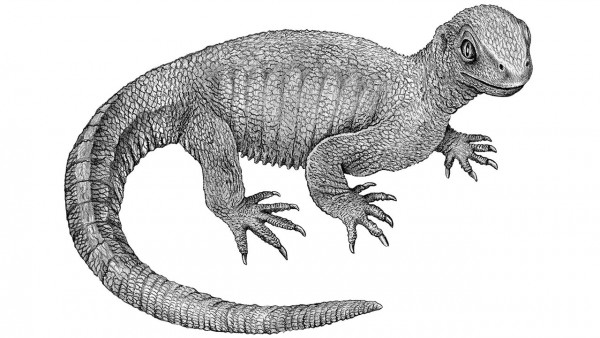It’s a primitive turtle, but it looks nothing like today’s dome-shelled reptiles. Resembling a broad-bodied, short-snouted lizard, the 240-million-year-old creature—dubbed Pappochelys rosinae—appears to be a missing link between prototurtles and their modern relatives, according to a new study. If so, the find could fill in a number of pieces about turtle evolution.
The findings are “a very important contribution in addressing who turtles are related to, as well as the evolutionary origin of the turtle shell,” says Tyler Lyson, a vertebrate paleontologist at the Denver Museum of Nature & Science who was not involved with the study. “These have been two vexing questions for evolutionary biologists for the last 200 years.”
About two dozen or so fossils of the creature have been recovered, all of them from 240-million-year-old rocks deposited as sediment on the floor of a shallow, 5-kilometer-long lake in what is now southern Germany. Most of the remains include only bits of bone and are from individuals of various sizes, says Hans-Dieter Sues, a vertebrate paleontologist at the Smithsonian Institution's National Museum of Natural History in Washington, D.C. But between the two most complete specimens yet found, he and Rainer Schoch, a paleontologist at the State Museum of Natural History Stuttgart in Germany, have put together a full skeleton and most of a skull.
P. rosinae adults likely measured about 20 centimeters long, with half of that being a long, whiplike tail. (The species name is a combination of the Greek words for “grandfather turtle” and the person who helped clean rock from the fossils to prepare them for analysis.) Its peglike teeth suggest the animal fed on worms and other soft-bodied prey, Sues says. Yet skeletal anatomy reveals Pappochelyswas no run-of-the-mill lizard, Sues and Schoch report online today in Nature.
Unlike lizards, but much like the earliest known relative of turtles (Eunotosaurus, which lived in what is now South Africa about 20 million years earlier), Pappochelys’s ribs are broad, dense, and have a T-shaped cross section. In later, full-shelled species of turtles, those ribs are even wider and have fused with each other and certain bones in the shoulder girdle to form a carapace, or upper shell. But unlike the earlier Eunotosaurus, Pappochelys has gastralia, or belly ribs. These free-floating bones developed within the tissue of the underbelly, Sues says; in more evolved species of turtles, these gastralia broaden and fuse to form a plastron, or lower shell.
Because the fossils were originally entombed in lake floor sediments, the researchers suggest thatPappochelys spent a lot of its time in the water and around the lakeshore—a lifestyle similar to that of today’s marine iguanas, Sues says. So having broad, dense bones and gastralia would have acted like a diver’s weight belt, helping Pappochelys fight buoyancy and forage on the lake’s bottom. But these bones would also have had a beneficial side effect: They would have offered some degree of protection from predators, such as large amphibians or fish living in the lake, by deflecting or blunting their bites.
“In the water, predators can get you from all angles,” Sues notes. Over millions of years, evolution sculpted the bones to create the full set of body armor seen in modern-day turtles. The first full-shelled turtles show up in the fossil record about 205 million years ago.
The two distinctive holes on the side of the head behind each eye of Pappochelys provide vital clues to the evolutionary heritage of turtles, says Torsten Scheyer, a vertebrate paleontologist at the University of Zurich in Switzerland who was not involved in the work. Those holes mark the species as a member of the diapsid (“two arches”) group of reptiles. That diapsid group includes crocodiles, lizards, snakes, dinosaurs, and their surviving kin, birds. But because modern turtle skulls lack these holes, some scientists have proposed that turtles were the last surviving members of an anapsid (“no arches”) lineage of reptiles. But now, he adds, these fossils of turtle progenitors firmly back up the results of genetic analyses of living reptiles: Turtles belong on the diapsid branch of the reptilian family tree.
Scheyer says fossils that are even more complete, or ones that have the bones preserved in more lifelike arrangements, would provide better information about the species. “I’m really looking forward to see more research done on these outstanding fossils.”
Source: AAAS, Full Article


